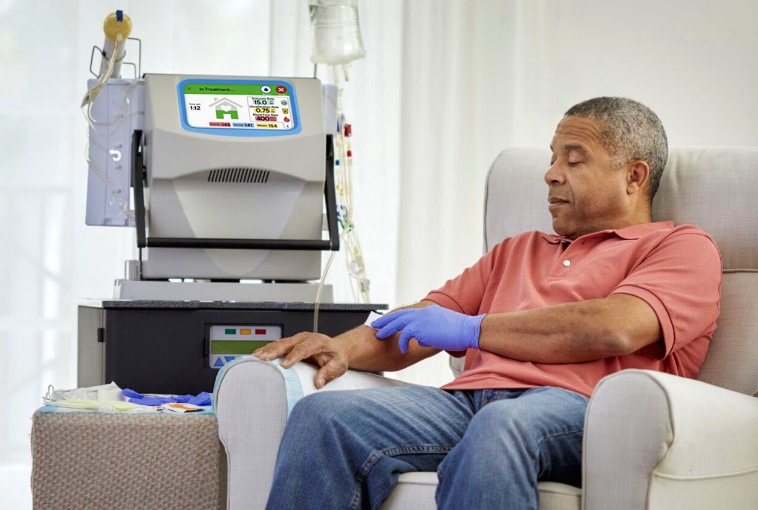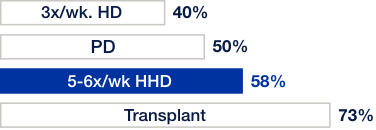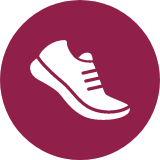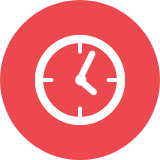Home Hemodialysis Customer Support: 866-697-8243
Peritoneal Dialysis Customer Support: 800-323-5188
Talk to a Patient Consultant About Home Dialysis: 888-200-6456
Home Hemodialysis Customer Support: 866-697-8243
Peritoneal Dialysis Customer Support: 800-323-5188
Talk to a Patient Consultant About Home Dialysis: 888-200-6456
Home Hemodialysis Customer Support: 866-697-8243
Peritoneal Dialysis Customer Support: 800-323-5188
Talk to a Patient Consultant About Home Dialysis: 888-200-6456
Home Hemodialysis Customer Support: 866-697-8243
Peritoneal Dialysis Customer Support: 800-323-5188
Talk to a Patient Consultant About Home Dialysis: 888-200-6456
Solo home hemodialysis (HHD) is an innovative option made available in 2017, when the NxStage® systems became the first and only hemodialysis machines cleared in the US for HHD without a care partner, during waking hours. That means more patients – even those who live alone and/or don’t have a care partner – may be able to experience the potential benefits of more frequent HHD.
IS IT POSSIBLE TO PERFORM DIALYSIS TREATMENTS ALONE AT HOME?
Yes, if you and your doctor agree, and with proper planning and training, many patients are able to perform their dialysis therapy alone, in the comfort of their home.
Solo home dialysis, sometimes referred to as self- or independent dialysis, is dialysis therapy administered at home, by yourself, without any required assistance. Kidney disease patients have two therapy options for solo treatment–more frequent home hemodialysis (HHD) and peritoneal dialysis (PD), both have been associated with many clinical benefits compared to traditional three-times weekly in-center hemodialysis (ICHD).1 Since PD is almost always done independently at home, here we will focus more on solo HHD.
WHAT IS REQUIRED TO PERFORM SOLO HHD?
If you and your doctor decide solo HHD is a good option for your health and lifestyle, you will first need a prescription for the therapy. You will also need a NxStage HHD system, dialysis treatment supplies, ancillary treatment supplies, and additional training to perform treatments alone, at home.
Your home training nurse will teach you to administer treatments yourself as well as proper techniques for using the ancillary devices listed below. Videos and other supplemental training materials are available online as well.
- NxStage fluid detection system. This includes the cycler base, extended cycler base, filterholder, and fluid detection sensor. (Your training center will provide this equipment.)
- Venous needle dislodgment device. This device alerts you with an audible alarm in the event of a vascular access blood leak. (Your training center will provide this equipment.)
WHEN CAN SOLO HHD TREATMENTS BE DONE?
You can perform solo HHD anytime during waking hours, which means you can adapt your dialysis treatments to your schedule and lifestyle, not the other way around.
ARE THERE ANY ADDITIONAL CONSIDERATIONS FOR PATIENTS CONTEMPLATING SOLO HHD?
There are some physical limitations that could affect a person’s ability to perform solo home hemodialysis. As always, your doctor and care team should help with these decisions and determine the best approach.
Some patients may feel uneasy about learning to self-cannulate, however, many people prefer self-cannulation once they are trained to do it properly.
WHAT ARE SOME OF THE REASONS PATIENTS MIGHT CHOOSE SOLO HHD:
Greater control and ownership of your care
When it comes to self-care, no one knows your body, comfort levels, and preferences better than you. Administering treatments yourself means you aren’t just “along for the ride,” you’re playing a proactive role in your therapy.
Increased scheduling independence and flexibility
Without a nurse, care partner, or dialysis clinic impacting treatment times, your schedule is your own. You, along with your doctor and care team, can choose to do dialysis when it works best for you, your family, your job, etc.
Less reliance on friends and family
Dialysis patients can sometimes feel like a burden to those around them. Solo HHD means counting less on others and more on yourself. It means more freedom for you and your friends and family.
Home is the most practical setting to do more frequent HHD
Nieltje had been living with kidney disease for almost 20 years and was determined to avoid in-center dialysis at all costs.
In-center treatments were difficult for Nieltje to balance in between taking care of her family and herself. As a solo patient, Nieltje regained her independence and took control over her life and treatments.
Rosheen’s dialysis journey took him down many paths, including solo HHD.
A little block of “cheese” went a long way for Rosheen. After some cannulation practice, he found the confidence to start more frequent solo HHD and the energy to do more of the things he loves.
What are some of the possible Benefits of More Frequent HHD?
(including more frequent solo HHD)
Fluid and toxin removal with more frequent HHD is closer to that of a healthy kidney, which works 24 hours a day, 7 days a week.2
Talk to a Patient Consultant
Complete the form to learn more about the benefits of more frequent home dialysis.
Risks and Responsibilities
Patients should review the following information carefully and discuss it with their doctors to decide whether home hemodialysis with NxStage systems is right for them.
Users Should Weigh the Risks and Benefits of Performing Home Hemodialysis with NxStage Systems.
- Medical staff will not be present to respond to health emergencies that might happen during home treatments, including, among other things, dizziness, nausea, low blood pressure, and fluid or blood leaks.
- Users may not experience the reported benefits of home, more frequent, or nocturnal hemodialysis with the NxStage systems.
- The NxStage systems require a prescription for use.
- Medical staff will not be present to perform home treatments. Users will be responsible for, among other things, equipment setup, needle insertions, responding to and resolving system alarms, system tear-down after treatment, monitoring blood pressure, ensuring proper aseptic technique is followed, and following all the training material and instructions that nurses provide.
Users Will Need Additional Resources to Perform Home Hemodialysis.
- Users will need a trained care partner to be present during your treatment at home (unless their doctor prescribes “solo/independent” home hemodialysis, described below).
- Users must have a clean and safe environment for their home treatments.
- Users will need space in their home for boxes of supplies necessary to perform home hemodialysis with NxStage systems.
Certain Forms of Home Hemodialysis Have Additional Risks.
- If a doctor prescribes home hemodialysis more than 3 times a week, vascular access is exposed to more frequent use which may lead to access related complications, including infection of the site. Doctors should evaluate the medical necessity of more frequent treatments and discuss the risks and benefits of more frequent therapy with users.
- If a doctor prescribes “solo/independent” home hemodialysis without a care partner during waking hours, risks of significant injury or death increase because no one is present to help users respond to health emergencies. If users experience needles coming out, blood loss, or very low blood pressure during solo/independent home hemodialysis, they may lose consciousness or become physically unable to correct the health emergency. Users will need additional ancillary devices and training to perform solo/independent home hemodialysis.
- If a doctor prescribes “nocturnal” home hemodialysis at night while the user and a care partner are sleeping, risks increase due to the length of treatment time and because therapy is performed while the user and a care partner are sleeping. These risks include, among other things, blood access disconnects and blood loss during sleep, blood clotting due to slower blood flow or increased treatment time or both, and delayed response to alarms when waking from sleep. A doctor may need to adjust users’ medications for nocturnal home hemodialysis, including, among other things, iron, Erythropoiesis-Stimulating Agents (ESA), insulin/oral hypoglycemics, anticoagulants, and phosphate binders.
The reported benefits of peritoneal dialysis may not be experienced by all patients.
Peritoneal dialysis does involve some risks that may be related to the patient, center, or equipment. These include, but are not limited to, infectious complications. Examples of infectious complications include peritonitis and exit-site and tunnel infections. Non-infectious complications include catheter complication such as migration and obstruction, peritoneal leaks, constipation, hemoperitoneum, hydrothorax, increased intraperitoneal volume, and respiratory and gastric issues. It is important for healthcare providers to monitor patient prescriptions and achievement of adequate fluid management goals.
Patients should consult their doctor to understand the risks and responsibilities of performing peritoneal dialysis.
REFERENCES
- Alice Chedid and Daphne H. Knicely: Chapter 9 Overview of Benefits and Limitations of Home Hemodialysis. Handbook of Home Hemodialysis. Daphne H. Knicely, Emaad M. Abdel-Rahman and Kelko I Greenberg (eds.). McGraw Hill, 2021.
- Daugirdas, John T.; Blake, Peter G.; and Ing, Todd S., “Handbook of Dialysis (5th ed.)” (2015).
- U.S. Renal Data System, USRDS 2015 Annual Data Report: Table 6.3. USRDS 2016 Annual Data Report: Table 6.3 (1996 – 2012) & matched 2012 NxStage patient data on file.
- Kotanko P, Garg AX, Depner T, et al. Effects of frequent hemodialysis on blood pressure: Results from the randomized frequent hemodialysis network trials. Hemodial Int. 2015;19(3):386-401.
- Finkelstein FO, Schiller B, Daoui R, et al. At-home short daily hemodialysis improves the long-term health-related quality of life. Kidney Int. 2012;82(5): 561-569.
- Jaber BL, Lee Y, Collins AJ, et al. Effect of daily hemodialysis on depressive symptoms and post-dialysis recovery time: interim report from the FREEDOM (Following Rehabilitation, Economics and Everyday-Dialysis Outcome Measurements) Study. Am J Kidney Dis. 2010;56(3):531-539.
- Rayner HC, Zepel L, Fuller DS, et al. Recovery time, quality of life, and mortality in hemodialysis patients: the Dialysis Outcomes and Practice Patterns Study (DOPPS). Am J Kidney Dis. 2014;64(1):86-94.
APM2222 Rev. C
350 Merrimack Street
Lawrence, MA 01843
United States
350 Merrimack Street
Lawrence, MA 01843
United States
920 Winter Street
Waltham, MA 02451
United States
920 Winter Street
Waltham, MA 02451
United States
1-866-NxStage (697-8243)
1-866-NxStage (697-8243)
© 2025 Fresenius Medical Care. All Rights Reserved.
© 2025 Fresenius Medical Care. All Rights Reserved.










